07年高考复习建议(安徽)[下学期]
图片预览

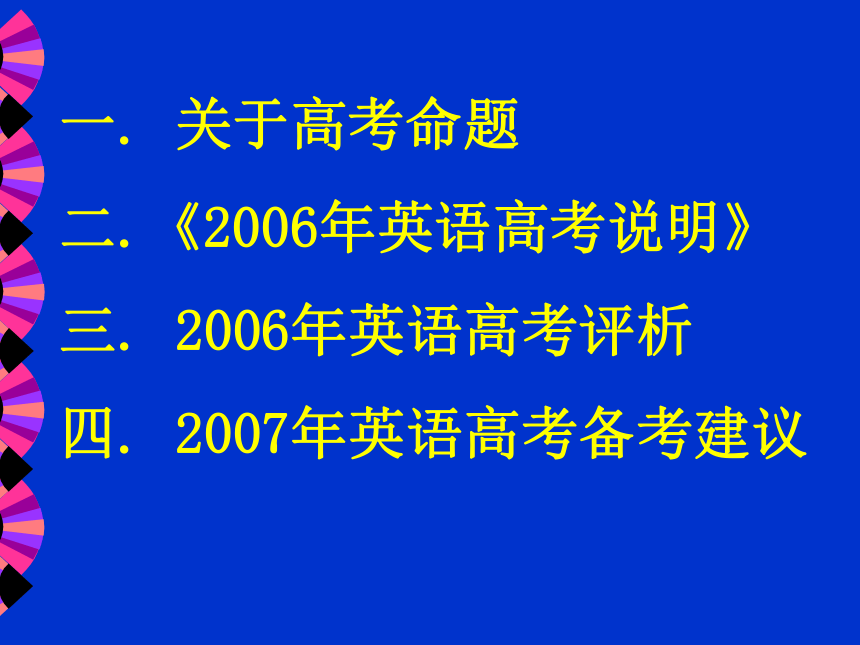





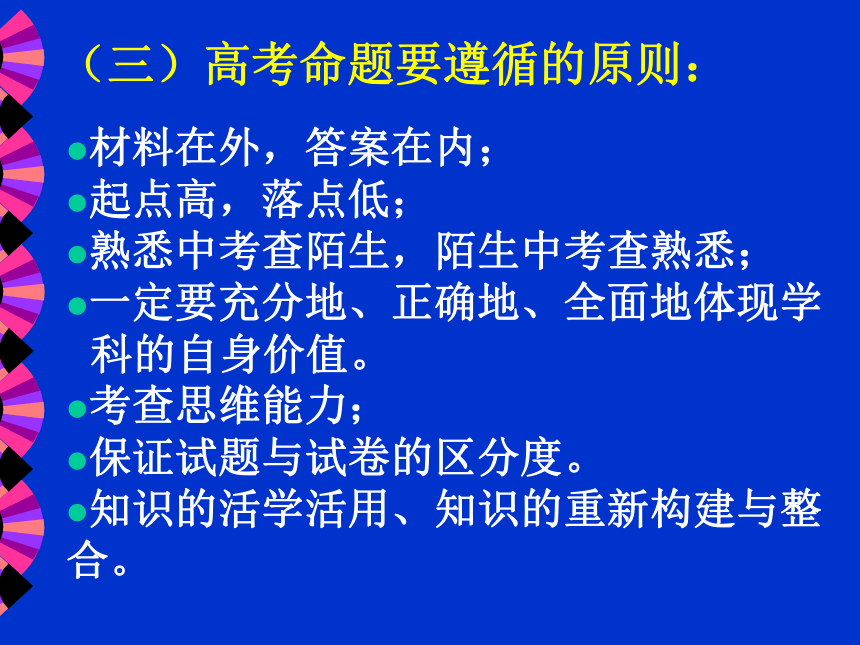
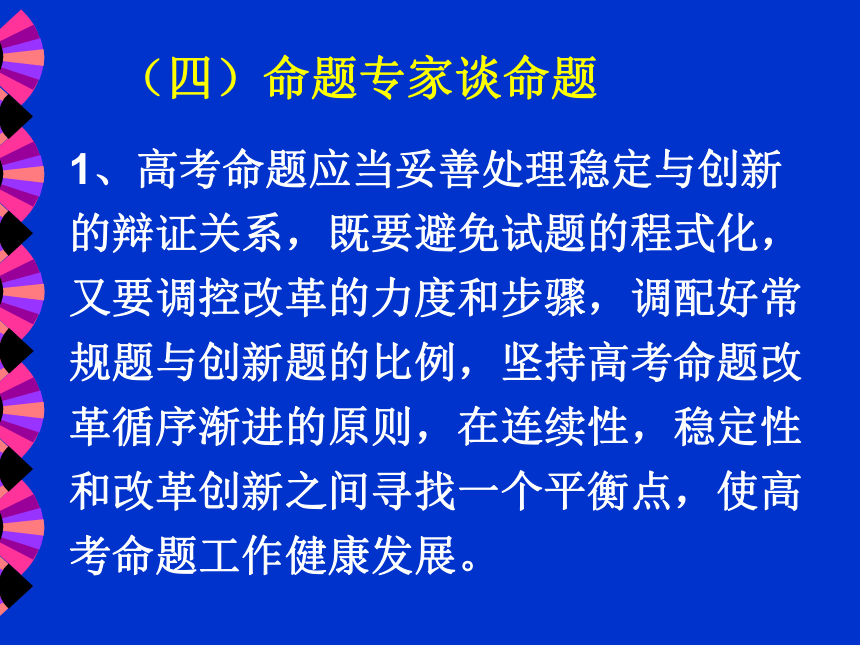
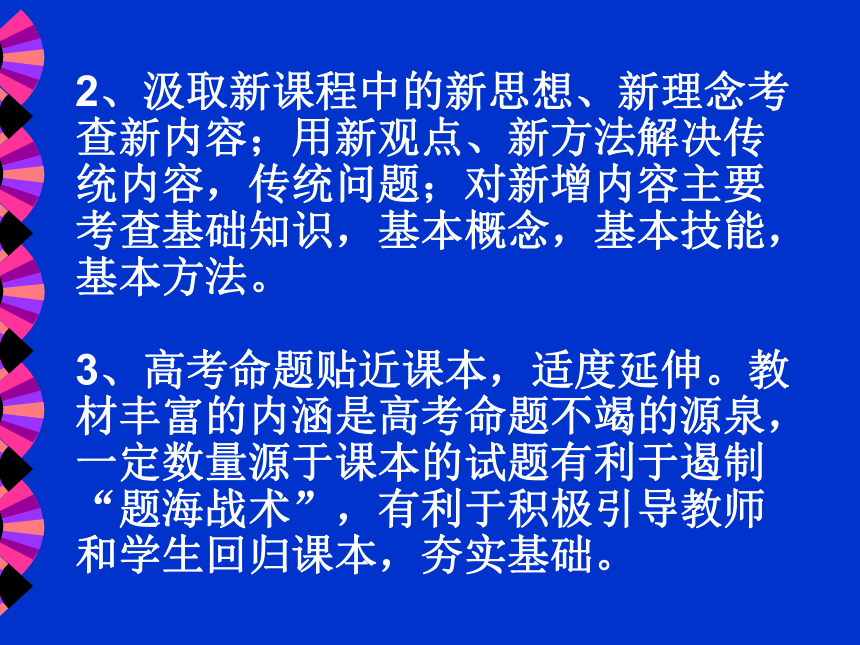

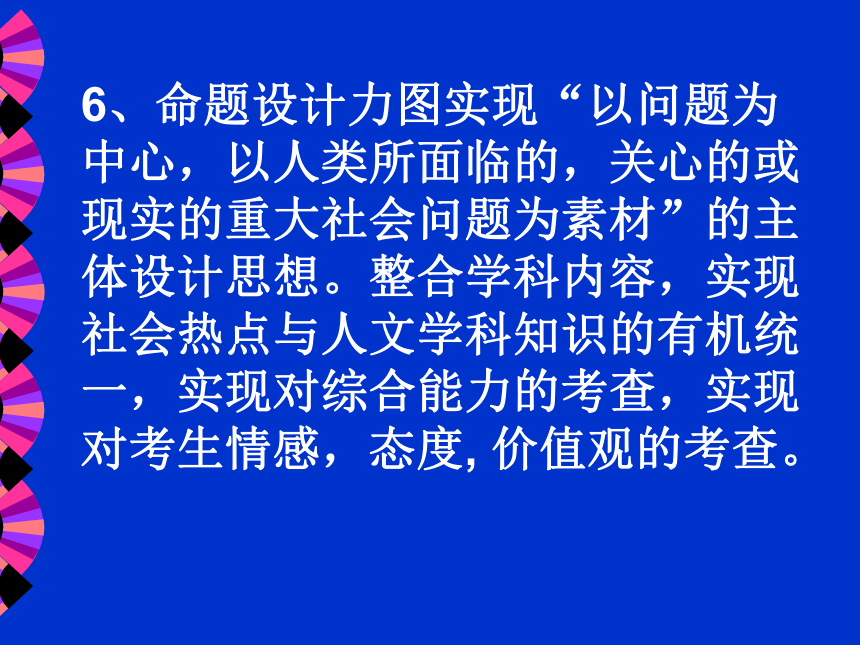
文档简介
课件137张PPT。Good Morning!一. 关于高考命题
二.《2006年英语高考说明》
三. 2006年英语高考评析
四. 2007年英语高考备考建议一. 关于高考命题
(一)知识的考查
高考考查的知识是对高中所学知识的抽样!
命题专家如何进行抽样?
源于命题专家对某一个学科的基本理论、基本框架的认识水平;
源于命题专家认为哪些概念和规律,哪些知识对培养中学生的学科素养是重要的;
源于命题专家认为哪些知识点对进入高校学习相关专业是必不可少的;
源于命题专家认为哪些知识点对培养学生的分析问题、思维能力及思维品质具有启迪作用。 (二)能力的考查
根据高考改革的指导思想,高考内
容改革应满足以下几点要求:
高考内容不应超出中学《教学大纲》的
范围,实际上就是《考试大纲》的范
围;
所考查的能力要求应是《考试大纲》中
规定的能力和层次,当然这些都是高中
毕业生应具备的或者能达到的;试题应保持适当的区分度,因为这样有利于各类高等学校选拔录取;
选择题、填空题、问答题、计算题、作文题等题型应维持一个恰当的比例,有利于考查不同层次的能力。
试题的难度应当适中,不应过难或过易,试题的难度还应该有一个合理的分布; (三)高考命题要遵循的原则:
材料在外,答案在内;
起点高,落点低;
熟悉中考查陌生,陌生中考查熟悉;
一定要充分地、正确地、全面地体现学
科的自身价值。
考查思维能力;
保证试题与试卷的区分度。
知识的活学活用、知识的重新构建与整合。 (四)命题专家谈命题
1、高考命题应当妥善处理稳定与创新的辩证关系,既要避免试题的程式化,又要调控改革的力度和步骤,调配好常规题与创新题的比例,坚持高考命题改革循序渐进的原则,在连续性,稳定性和改革创新之间寻找一个平衡点,使高考命题工作健康发展。2、汲取新课程中的新思想、新理念考查新内容;用新观点、新方法解决传统内容,传统问题;对新增内容主要考查基础知识,基本概念,基本技能,基本方法。
3、高考命题贴近课本,适度延伸。教材丰富的内涵是高考命题不竭的源泉,一定数量源于课本的试题有利于遏制“题海战术”,有利于积极引导教师和学生回归课本,夯实基础。4、消除个别试题设问的歧义,不给考生理解题意带来麻烦和困难是命题的一个永恒的话题,也是高考命题时需要特别关注的。
5、试题要重视对考生的科学素质的考查,人文素质的考查,引导学生关注科学技术和社会经济发展,引导学生关注人类之间、人与自然的和谐发展,以利于激发学生学习科学的兴趣,形成科学的价值观和实事求是的科学工作态度。6、命题设计力图实现“以问题为中心,以人类所面临的,关心的或现实的重大社会问题为素材”的主体设计思想。整合学科内容,实现社会热点与人文学科知识的有机统一,实现对综合能力的考查,实现对考生情感,态度, 价值观的考查。7、试题以发展为核心,突出科学发展、均衡发展、全面发展、和平发展、和谐发展的观念,通过具体试题的情境,引导考生关注人的发展,关注公共事业,关注社会弱势群体、关注人与自然的协调,关注整个社会的和谐发展和国际环境的稳定。 8、关于作文命题
作文命题的方式可能会变,但写作的要求不会变。
?在命题思想上, “控制性写作”的原则不会变;
?在写作内容上,“人、自然、社会”这三个层面不会变; 学生要关注自己所处时代,了解生活、要有参与感,要有精神体验、情感体验、审美体验。
?在思维方式上,要求思维的逻辑性和严谨性不会变。 (五)试题难度调控原则
试题的设问基本上是由浅入深,大进 口,小出口,切入容易,深入难;注意试题的梯度与层次,追求试题、试卷的区分度,体现了选拔考试的效能。
控制试卷入口题的难度;
控制题型入口题的难度;
较难试题采用分步设问,分步赋分;
控制新题型比例,“新”就意谓“难”;
控制难题比例。 (六)高考命题程序
对上一年度试题进行评价;
召开命题预备会,在评价的基础上确定命
题指导思想和命题思路;
制定双向细目表,修编《考试大纲》;
征题;
征题的筛选与整理;
召开命题会,组卷;
试卷冷却;
审题;
修改定稿;一票否决; (七)试题评价标准
试卷
试卷设计体现《考试大纲》的要求,不超
出中学《教学大纲》的要求。
考查学科的主体内容,即中学重点内容与
大学学习相关密切的内容。
反映知识的内部联系和基本规律,体现理
论联系实际的原则。
考查基础知识,基本技能以及在此基础上
形成的分析、解决问题的能力。
控制试卷长度,中等程度的考生能在规定的时间内完成全卷。
题目难、中、易比例合理。有效地控制试卷难度。
试题
题目设计体现运用已有知识解决新问题的能力考查要求。
试题科学、规范;测试目标明确。
题目的立意、情境、设问的角度及方式科学、可信、新颖、灵活。
难度合适, 有较好的区分度。 选择题
题干围绕一个中心,选项和题干的关系一致。
干扰项有效,能反映考生的典型错误。
各选项的结构、长度大体一致。
正确选项分布均匀。
非选择题
考查主要的、重要的、较高层次的学科能力。
答题量与赋分值合理
二. 《2006年英语高考说明》 安徽省2006年《考试说明》规定了: 1.考试内容
2.考试形式与试卷结构(一)考试内容
A.语言知识
B.语言运用语言知识
要求考生能够适当运用基本的语法知识,掌握2000左右的词汇及相关词组。 (见附录)
语言运用
听力
要求考生听懂有关日常生活中所
熟悉话题的简短独白和对话。
考生应能:
1)理解主旨要义;
2)获取事实性的具体信息;
3)对所听内容作出简单推断;
4)理解说话者的意图、观点或态
度。阅读
要求考生读懂熟悉的有关日常生活话题的简短文字材料,例如公告、说明、广告以及书、报、杂志中关于一般性话题的简短文章。
考生应能:1)理解主旨要义;
2)理解文中具体信息;
3)根据上下文推断生词的词义;
4)作出简单判断和推理;
5)理解文章的基本结构;
6)理解作者的意图和态度。 写作
要求考生根据提示进行书面表达。
考生应能:
1)准确使用语法和词汇;
2)使用一定的句型、词汇,清
楚、连贯地表达自己的意思。(二)考试形式与试卷结构
1.答卷方式:闭卷、笔试。
2.考试时间:120分钟。
试卷满分为150分。
3.试题难易比例:
试卷以中等题为主。全卷难度控制在0.5—0.6之间,或者说是控制在0.55左右。试题的难中易的比例: 2∶6∶2
或 2∶5∶3
4. 题型
一、多项选择题
1)考查听力
2)考查语法和词汇知识
3)考查阅读理解
二、完型填空题
三、短文改错题
四、书面表达题
三. 2006年安徽英语高考试卷
评 析基本特点:
命题原则保持一致。
与考纲保持一致。
语言知识题保证知识覆盖面,尽可能增加综合性与语境化的因素; 语言运用强调语言的交际性。
题型结构稳定。
难度系数保持稳定。 听力
语速较缓慢,语音清晰,问题较浅显, 容易得分。 2. 语法和词汇知识题(单选题)
难度不大,考察的基本上都是常规语法项目,多在特定的语境中对语法和词汇知识进行考查。3.完型填空
内容是学生熟知的,淡化语法的考察,只要能理解这篇短文,根据文章的脉络和词组搭配就可做出准确的选择。38, 40, 44, 47, 49, 51稍难 4.阅读理解
理解容易(E篇除外),得分难。整个部分没有一个阻碍学生阅读的新词,有17个带汉字解释的单词,但其中有13个词属于中学阶段学生应该会的单词。58, 65, 67, 745.短文改错
基本上属于常规错误设置, 比较容易得分。 6. 写作
限制性写作,文体熟悉,信息较简单,难度不大。 评分标准:
1. 信息完整; 2. 表达正确; 3. 语言流畅。四. 2007年英语高考备考建议(一)高考复习的几种错误倾向:
1. 忽视教材、忽视《教学大纲》、《课程标准》;教学大纲是依据,教材是依托。
2. 重视模拟试卷,忽视《考试大纲》;
《考试大纲》才是命题的依据。
3. 重视高三总复习,忽视高一高二的教学。4.重视结果,忽视思维过程和思维品质,忽视推理过程对认知的影响。
5. 重视教师自己讲,忽视学生自己想。讲清楚不如想清楚,想清楚不如做清楚。
6. 重视全班授课,忽视个别辅导。 (二)高考复习建议要点
★把握考纲,有的放矢
★夯实基础,培养能力
★熟悉题型,训练技巧
★沉着冷静,严谨细致
★把握考纲,有的放矢 ★把握考纲,有的放矢
1)命题原则保持一致
2)高考英语试卷题型结构稳定
3)以考查语言运用为主,以考查
语言知识为辅
4)强调语言测试的交际性原则
5)试卷难度保持一致★夯实基础,培养能力 ★夯实基础,培养能力 一.基本词汇
二.基础语法
三.文化交际 一.基本词汇
1)以《考试说明》中规定的2000多个常用词为底线,应准确记忆它们的拼写形式、基本词性、词义、常见搭配,尤其要掌握它们在语境中的运用。
2)增强构词法的知识,了解常见的合成词、派生词和词类转化,扩大词汇量。
3)有意识地积累大纲外的常用词,至少熟悉课本上出现的词汇。 二.基础语法
1.词 法
2.句 法 词法
1)名词 2) 形容词 3)副词
4)动词 5)代词 6)冠词 7)数词 8)介词 9)连词
10)感叹词动 词1)动词的基本形式:现在式, 过去
式,过去分词,-ing形式
2) 动词的及物性和不及物性
3)连系动词 be, get ,look…
4)助动词 be , do , have…
5)情态动词 can, may, must…6)动词的时态
(1)一般现在时
(2)一般过去时
(3)一般将来时
(4)现在进行时
(5)过去进行时
(6)现在完成时
(7)过去完成时
(8)过去将来时
7)动词的被动语态
非谓语动词
8)动词的不定式
1)作主语 2)作宾语
3)作宾补 4)作状语
5)作定语 6)作表语
7)用在how, when, where,
what, which, who,
whether 等后面
9)动词的过去分词
1)作定语 2)作表语
3)作宾语补足语 4)作状语
10)动词的-ing形式
1)作主语 2)作宾语
3)作宾语补足语 4)作表语
5)作定语 6)作状语动词考查的热点情态动词 :
1.能力 can, be able to
2.许可 can, may, could, might, mustn't
3.责任 should, ought to, must, have to
4.可能 must, can(n’t), should, ought to,
may, might, could
5. shall, will
6. need, dare
7.情态动词 +have+pp
8.其他用法(含虚拟语气)辽宁2005
This cake is very sweet. You ____ a lot of
sugar in it.
A. should put B. could have put
C. might put D. must have put
湖北2005
—Do you know where David is? I couldn’t
find him.
—Well. He ____ have gone far — his coat’s
still here.
A. shouldn’t B. mustn’t C. can’t D. wouldn’t
安徽2005
Helen ______ go on the trip with us,
but she isn’t quite sure yet.
Shall B. must C. may D. can
重庆2004
“The interest ______ be divided into
five parts, according to the agreement
by both sides,” declared the judge.
A. may B. can C. must D. shall动词的时态
时间性: 过去, 现在, 将来
2. 语法意义: 一般式, 进行式, 完成式
e.g. NMET97
— Who is Jerry Cooper?
— _____ ? I saw you shaking hands with him at the meeting.
Don’t you meet him yet
Hadn’t you met him yet
Didn’t you meet him yet
Haven’t you met him yet(安徽06) 25.I _____ along the street looking for a place to park when the accident _____ .
A.went; was occurring B.went; occurred
C.was going; occurred
D.was going; had occurred
湖南2005
— If the traffic hadn’t been so heavy, I could have been back by 6 o’clock.
— What a pity! Tina _____ here to see you .
A. Is B. was
C. would be D. has been非谓语动词
主被动关系— 逻辑主语
时间性— 与句子谓语动词之间的先后顺序
e.g. (安徽06)
35.Mr. Green stood up in defence of the 16-year-old boy, saying that he was not the one _____ .
A.blamed B.blaming
C.to blame D.to be blamed(安徽06)
21.My cousin came to see me from the country, ____ me a full basket of fresh fruits.
A.brought B.bringing
C.to bring D.had brought
NMET2005
The storm left, ____ a lot of damage to this
area.
A. caused B. to have caused
C. to cause D. having caused
句法
1. 简单句的五种基本句型
2. 并列句
3. 复合句
1)名词性从句
2)状语从句
3)定语从句
4. 特殊句式 1)倒装句 2)省略句
3)感叹句 4) 强调句,etc.
1. 句子结构
Although … but …; Because…so…
e.g. The little child ran in, ____ face red
with cold. (whose; his)
2. 三大从句的解题突破口
1)名词性从句: 缺不缺成分, 缺什么成分
2)状语从句: 从句分类, 连词辨析
3)定语从句:关系词代替先行词,在从句中
充当成分(安徽06)
29.A warm thought suddenly came to me ____ I might use the pocket money to buy some flowers for my mother’s birthday.
A.if B.when C.that D.Which
NMET98
____ it with me and I’ll see what I can do.
A. When left B. Leaving
C. If you leave D. Leave
湖南2004
I think Father would like to know ____ I’ve been up to so far, so I decided to send him a quick note.
A. which B. why C. what D. how
浙江2005
Jim passed the driving test, ___ surprised
everybody in the office.
A. which B. that C. this D. it
三.文化交际 三.文化交际
了解主要英语国家的风俗习惯和生活方式
初步了解主要英语国家的文化和历史背景
初步了解主要英语国家的政治和经济等方面情况
了解英语国家的主要宗教传统
对比中外文化, 加深对中国文化的理解
熟悉课本中的语言功能话题及相关表达★熟悉题型,训练技巧★熟悉题型,训练技巧
一、听力
二、语法和词汇知识
三、完型填空
四、阅读理解
五、短文改错
六、书面表达
一、听力(一)听力题的命制
材料选定: 真实性, 口语化, 语境明确, 不含生词
题目设置: 布点均匀, 考点多样,设题简明, 答案唯一
磁带录制: 英美口音, 语音纯正,语速较慢, 时间规范
(二)听力测试要点
对话或独白的主旨
对话地点(特定场景用词)
人物身份及人物间关系
数字处理:时间、价格、号码
前因后果(三)听力应试策略
1.利用试听,调整情绪
2.快速浏览,预测内容
3.捕捉信息,速记要点
4.,概括分析,当机立断(四)复习建议
1.训练朗读技巧
2.拥有足够词汇
3.熟悉常用句式
4.了解文化背景
5.加强技巧训练二、语法和词汇知识(一)测试要点
语法知识的理解和运用能力
词组搭配和习惯用法
对词义的正确理解能力
英语口语交际能力北京2005
He _____ have completed his work;
otherwise, he wouldn’t be enjoying
himself by the seaside.
should B. must C. wouldn’t D. can’t
浙江2005
I am sure David will be able to find the
library. He has a pretty good _____ of
direction.
A. idea B. feeling C. experience D. senseNMET2004
You can take anything from the shelf and
read, but please _____ the books when
you’ve finished with them.
put on B. put down
C. put back D. put off
浙江2005
—People should stop using their cars and start using public transport.
—_____. The roads are too crowded as it is.
All right B. Exactly
C. Go ahead D. Fine(二)解题误区
定式思维
汉语思维
断章取义
忽视结构NMET96
I love to go to the seaside in summer. It ____ good to lie in the sun or swim in the cool sea.
A. does B. feels C. gets D makes
NMET2004
You are saying everyone should be equal, and this is ____ I disagree.
A. why B. where C. what D. how— It was fine yesterday.
— _____. And a very day for fishing, isn’t it?
So it was B. It is so
C. So it is D. So is it
上海2001
Have you seen the film “Titanic”, _____
leading actor is world famous?
A. its B. it’s C. whose D. which(三)应试策略
1. 理解题干, 把握语境
2. 寻找依据, 形义结合
3. 运用技巧, 排除干扰
4. 兼顾文化, 考虑交际1. Tom ought not to ____ me your secret, but he meant no harm. (NMET1993)
????? A. have told? ??B. tell???
C. be telling??? ??D. having told
2. When I got back home I saw a message pinned to the door, ______ “Sorry to miss you; will call later.” (NMET 1999)
?????? A. read???? ? ? B. reads????? ?
C. to read???? ?D. reading
3. The managers discussed the plan that they would like to see ____ the next year. (NMET 2000)
A. carry out B. carrying out
C. carried out D. to carry out
4. A cook will be immediately fired if he is found _____ in the kitchen. (NMET 2003)
?A. smoke??? B. smoking? C. to smoke? D. smoked
5. --- Waiter!
??? --- ______
???--- I can’t eat this. It’s too salty. (NMET2000)
?????? A. Yes, sir??????????????? B. What??????
?????? C. All right????? ? ????? ?D. Pardon?(四)复习建议
立足基础, 系统复习
对照考纲, 查缺补漏
注重思维, 明确依据
收集典型题, 建立错题本三、完型填空 (一)测试要点
词语运用: 常见搭配 , 习惯用法,
词义辨析
2. 逻辑推断: 语境把握, 句文衔接
3. 语法运用: 结合语篇 (二)应试策略
速读全文, 抓住主线
注重语篇, 兼顾语法
理清关系, 重视逻辑
先易后难, 各个敌破
检查全文, 确保流畅 (三)具体操作
1.充分利用上下文和前后句,寻找提示
e.g. Many old people don’t have good _____. they can’t watch TV, but they can listen to music or news over the radio.
hearing B. health C. eyesight D. time
2. 根据动作的发出者确定选项
e.g. When the papers were _______ she discovered that 12 boys had made exactly the same mistakes.
collected B. completed C. marked
D. answered3. 根据常识以及相关知识确定选项
e.g. Immediately, the officers jumped into their cars and rushed to the ___ hospital.
animal B. biggest C. plant D. nearest
4. 根据逻辑关系确定选项
e.g. A transistor radio is very easy to carry.
____, radio broadcasts are better for blind
people.
A. Besides B. However
C. Yet D. Sometimes5. 注意词义辨析
e.g. …but when he ____ it, it did not sound like flattery.
A. told B. said C. spoke D. talked
6. 注意固定搭配
e.g. In the end, one suggestion seems to be the solution ___ the problem.
with B. into C. for D. to
7. 其它方法: 语法运用, 排除法等四、阅读理解
(一)测试要点
理解主旨要义
理解具体信息
推测生词词义
简单判断推理
作者意图态度
文章基本结构 (二)题目设置
主旨要义题
☆The main idea/key point/purpose/subject
matter of this passage is that ______.
☆ From the passage we learn/can conclude
that _______.
☆ The last paragraph is chiefly concerned
with _______.
☆ What’s the best title/headline for the
passage?
☆ Which of the following statements best
expresses the main idea of the passage? 事实细节题
☆ According to the passage, who / what/ which /
when / Where / why / how / how many / how
much / how long / How soon / how often, etc. ?
☆ According to the passage, which of the following
is true/ not true?
☆ According to the passage, which of the following
is not mentioned ?
☆ All of the following are true EXCEPT _____.
☆ In the passage the write states that _____.
☆ Choose the best order in which the people do… 推测生词词义
☆ The word “…” refers to / probably
means / could best be replaced by _____.
☆ The word “…” most likely means _____.
☆ What do you think the expression “…”
stands for?
☆ By saying “…” we mean ______.
☆ “…”, as used in the passage, can best be
defined as _______. 简单判断推理
☆ It can be inferred/concluded/seen from
the passage that ______.
☆ Which of the following conclusions can
we draw according to the passage?
☆ The passage implies but doesn’t directly
state that ______.
☆ The writer suggests that ______.
☆ According to the author, which of the
following best describes the tone of the
passage?
☆ The writer’s purpose in writing this text
is_______. 作者意图态度
☆ The write thinks that ______.
☆ The author’s attitude towards … is_____.
☆ What is the writer’s opinion concerning
…?
☆ Which of the following best describes the writer’s attitude towards …?
(三)应试策略
通读全文, 了解大意
带题阅读, 寻找信息
确定依据, 推理判断(四)具体操作
抓住题干信息, 针对性阅读, 处理事实题
利用构词法, 上下文语言信号等处理生词
边读文章边看图, 处理辨认图形题
找头尾, 对比中间项, 处理事实排序题
立足文章中已知信息, 推测未知Apple trees may grow as tall as twelve metres. They do best in areas that have very cold winters. Although no fruit is yielded during the winter, this cold period is good for the tree.
The word yielded in the last sentence means ______.
A. improved B. increased
C. produced D. sold This kind of flower thrives in this area because the weather is warm, the soil is excellent and there is a lot of rain.
A. grows well B. makes a few flowers
C. dies D. fails to grow In the sale fever, people were spending money like water without thinking whether they needed what they were buying. As long as it was a bargain, it was OK.
You won’t believe this but as soon as I got home, I crashed out for four hours. Then I had dinner and went back to bed, fearing the sound of the alarm which would tell me to get ready for the second day of the sale.
The expression “crashed out” means _____.
A. chatted with friends B. slept soundly
C. broke down D. dined out A radar set produces radio waves and then gives them out into space by means of its antenna. When the radio waves get to an object, they will come back to the radar antenna. The radar set then changes the radio echoes into an image. And from this image, we can find out the direction of the object and its distance from the set. How can the radar show us the distance to the object then? Radio waves go out at a known speed --- about 300,000 kilometres every second. If the radio waves come back in 1/1000 second, then they just have some 300 kilometres. So the object must be half that distance, that is, 150 kilometres away.
Which of the following orders show correctly how a radar works?
a. The operator determines the distance and the direction
according to the image.
b. Radio waves are sent out into space by radar.
c. The antenna receives the radio echoes and changes them into
an image.
d. The image of an object is shown on the screen.
A. a, d, c, b B. b, c, d, a C. a, b, d, c D. a, c, b, d Asian countries continue to find better ways to solve their pollution problems. Singapore introduced a Corrective Work Order campaign. C.W.O. requires those people who like to throw waste materials in a public place to do public service. They must clean beaches, parks and housing developments. As a result, rubbish has decreased.
Thailand uses fear to control throwing away rubbish. A rich Thai woman designed “magic eyes” to encourage people to protect the surroundings. The eyes were put up in schools and on every street corner.
Certainly the most expensive plan is Japan’s large vacuum. This vacuum will operate along Osaka’s dirtiest road. The vacuum sucks up the air and makes it clean.
The best tile for this passage is ________.
A.?Asian plans for pollution B.??Air pollution in Asia
C.?The problem of pollution D.??Keep the air clean五、短文改错 (一)命题特点
1.短文没有理解障碍
2.考查词法,句法,行文逻辑
3.错词为主(6),多词、缺词各1-2题.
4.测试热点: 冠词,名词数,动词时态,
非谓语动词,主谓一致,代词指代,
介词使用,形副错用及比较级,行文
逻辑及语义等 (二)应试策略
快读全文, 初步改错
句文结合, 先易后难
对照热点, 全面审读
确保原意, 通顺合理 (安徽06)
There is a public library in every town in Britain. Anyone 76.
can borrow books if he or she wish. In some please you 77.
may borrow as more books as you need, but in others 78.
you are limited in a certain number of books. You may 79.
keep the books for several weeks so as you can have 80.
enough time to finish it. If the book you want is out 81.
you may ask it to be kept for you. Most public libraries 82.
also have a reading-room, that you can sit at the desk 83.
and read the daily newspapers, magazines and the other 84.
books, but you are not permit to take them out. 85. 76. √ 77. wish →wishes 78. more →many 79. in →to 80. as →that 81. it →them 82. ask →ask for 83. that → where 84. the other → other85. permit →permitted1) We often watch football match on TV together. (97)
2) I’ll get good marks in all my subject. (01)
3) They will do all they can make sure that I get a
good education. (01)
4) Play football makes us grow up tall and strong.
5) I look forward to hear from you soon. (94)
6) There are too many people among my family.
7) We practise for three times every week. (98)
8) Unfortunate, there are too many people in my
family (99)
9) The Smiths did his best to make me feel at home. (96)
10) And they must not break the rules too often if
we want to win the game. (98)^ 11) It looks as if my parents treat me as a visitor and a
guest. (01)
12) Playing football not only makes us grow up tall and
strong but also give us a sense of fair play and team
spirit. (97)
13) Each player must obey captain, who is the leader of
the team. (95)
14) We may be one family and live under a same roof.
(2001)
15) Now, I can’t watch much television but a few years
ago I used to watch it every night. (99)
16) …but it didn’t matter that I would win or not.
(2000)
17) When I was on the stage the next day, I felt so
nervous as I shook like a leaf. (2000) 18) …she was smiling but nodding at me. (2000)(NMET 2000)
The day before the speech contest English teacher ①
talked to me. She said that she and my schoolmate all ②
wished me success, but it didn’t matter that I would ③
win or not. When I was on the stage the next day, I felt so ④
nervous as I shook like a leaf. There were so many people ⑤
present! Suddenly, I caught a sight of my English teacher in ⑥
the crowd. She was smiling but nodding at me. I remembered ⑦
her words and calm down, I did a good job and won the first ⑧
prize. Now my picture and the prize is hanging in the library. ⑨
Whenever I see them I will often think of my English teacher. ⑩
1. my English 2. schoolmates 3.that→whether 4. 正确
5. as → that 6. A 7.but → and 8. calm → calmed
9. is → are 10. often去掉 (三)应试准备
1.全面提高英语听说读写
2.多读多背地道短文,增强语感
3.留意高频率的错误现象
4.科学训练, 规范改法六、书面表达 (一)命题特点
要求考生根据所给情景,用英语写一篇100个单词左右的短文。情景包括:目的、对象、时间、地点、内容等; 提供情景的形式有图画、图表、提纲等.
考生应能:
1)准确使用语法和词汇;
2)使用一定的句型和词汇来清楚、
连贯地表达自己的意思。 (二)测试要点
1. 正确运用语法(用词、结构搭配、句型 、句式)来准确地道地传达信息
2. 运用一定的写作策略和篇章技巧(段落的构成、句子与句子和段落与段落间的过渡等)将信息得体流畅的传达,以达到交际的目的 (三)应试策略
1. 审题要准, 定位要清
2. 内容充实, 详略得当
3. 合情合理, 逻辑清晰
4. 语言准确, 交际顺畅
(四)评判原则
总体原则: 无过(错)就是功
金玉良言: 正确为先
流畅为好
有文采则妙
切记: 形式重于内容 (五)写作训练要点
1. 积累材料, 拥有足够语言储备
整理信息, 合理安排叙述顺序
灵活变通, 准确表达意思
语法规范, 句子结构多样化
巧妙过渡, 确保行文流畅
短文改错, 全文无错最重要
写出好句子
尽量用自己熟悉的句型和表达法
注重句子的多样性,简单句与并列句为主, 适量使用复合句及复杂句
掌握分、合句子的能力和技巧
确定好文章的基本时态,不要时态混乱
平时进行多种题材训练,并细读范文辩论式议论文
模版1:
Some people believe (argue, recognize, think) that 观点1. But other people take an opposite side. They firmly believe that 观点2. As for me, I agree to the former/latter idea.
There are a dozen of reasons behind my belief. First of all, 论据1.
More importantly, 论据2.
Most important of all, 论据3.
In summary, 总结观点. As a high school student, I am supposed to 表决心.
或 From above, we can predict that 预测. 模版2:
People hold different views about X. Some people are of the opinion that 观点1, while others point out that 观点2. As far as I am concerned, the former/latter opinion holds more weight.
For one thing, 论据1.
For another, 论据2.
Last but not the least, 论据3.
To conclude, 总结观点. As a high school student, I am supposed to 表决心.
或 From above, we can predict that 预测. 写作常见错误:
1. 动词与主语关系不清
误:I saw an old man going out of City Park and was about to cross Park Road.
正:I saw an old man going out of City Park and he was about to cross Park Road.
误:But the car ran off immediately instead of stopping to apologize to the man.
正:But the driver drove off immediately instead of stopping to apologize to the man. 2. 句子之间的逻辑关系不清
误:It hit the old man down but the driver, a woman, didn’t stop her car.
Finding she had caused an accident, the woman sped her car to flee away. The old man and I saw the car’s number. It’s AC864. The old man couldn’t move , I decided to help him.
正:It hit the old man down but the driver, who was a woman, didn’t stop her car. Finding she had caused an accident, the woman sped her car to flee away.
Fortunately, I saw the car’s number. It’s AC864. Noticing the old man couldn’t move, I decided to help him.3. 语言不简洁
修改前:
A famous sportsman was giving a speech which was rather interesting.
修改后:
A famous sportsman was giving an interesting speech.4. 句子过于简单,文章缺乏逻辑性, 可读性
修改前: Suddenly, a car run quickly from the third street and turned to the west. The car didn’t stop and hit the old man. The driver didn’t stop and have a look. The car ran away quickly. The car was yellow and the driver was a woman.
修改后: Suddenly, a car turned west from the 3rd Street to the Park Road. It hit the old man, but it didn’t stop and ran away quickly. I noticed the car was yellow and the driver was a woman.2005全国3
假设你是李华,最近国内一家英文报纸正在讨论北京动物园是否应迁出市区。以下是你所在班级讨论的情况。请你给该报写一封信,反映讨论结果。注意:1.词数100字左右,信的开头已为你写好。
2.可根据内容要点适当增加细节,以使行文连贯。
3.参考词汇: 郊区— suburb
June 3 ,2005
Dear Editor ,
Recently ,our class have had a heated discussion about whether the Beijing Zoo should be moved out of the city .Possible version:
June 3 ,2005
Dear Editor ,
Recently ,our class have had a heated discussion about whether the Beijing Zoo should be moved out of the city .
Some of my classmates are in favor of the move. They say that once moved, animals will have more space and better living conditions in the suburbs.
However, other students are against the idea, saying that the BJ Zoo, built in 1906, has a history of 100 years, and is well-known at home and abroad. So it should remain where it is. What’s more, moving may cause the death of some animals.
To move or not, this is a big decision which has to be made by people in BJ.
Yours truly,
Li Hua★沉着冷静, 严谨细致温馨提示:
明确依据, 排除干扰
先易后难, 把握节奏
利用线索, 顺藤摸瓜
卷面整洁, 慎涂答案★如何记忆单词?
1) 近义词:receive,accept;
hit,strike,beat,knock;
persuade,advise,suggest;
special(ly), especial(ly), particular(ly)
2) 反义词:shallow,deep;
thin,thick;
succeed,defeat;
3)构词法:
describe, description;
explain, explanation;
practice, practical;
pronounce, pronunciation
4)动词搭配:
①接不定式和动词-ing作宾语,意义
不同
如:regret, forget, remember,
mean, try ,stop, go on等
②可接宾语和宾补,形式却不同。
如:forbid, advise, allow, permit,
admit, consider等接动词-ing作宾语,但接宾补时 ,动词要用不定式。
③宾语形式不同、语态不同,意思却相同。
如:need, require, want, deserve等后面接-ing形式的主动式表示被动含意,与不定式的被动式意思相同。
worth, worthy的用法④只接不定式作宾语
如:decide, expect, refuse, hope, seem,
order, promise, pretend, offer, happen, ⑤动词-ing作宾语
如:risk, avoid, enjoy, escape, practise, suggest , appreciate , delay
⑥含“被动”意味的动词
如:sell, open, close, wash, burn, measure, cost, read, write, tear, drive5)与介词、副词搭配
例如:
名词time的搭配短语:in no time,on time,in time,at a time,behind the times,behind time,at one time,for a time,at other times,at times,at all times等
与on搭配的动词: get on,live on,feed on,take on,turn on,look on,call on,go on,have on,depend on,wait on,carry on,hold on,insist on,play tricks on,fix …on,impress … on等。 与on搭配的名词(注意冠词):
on duty,on business,on fire,on show,on time ,on strike,on watch,on sale,on earth,on foot,on purpose,on the way,on the contrary,on one hand,on the right,on the whole,on one's own,on one's side,on holiday/leave等 6)搭配活跃的动词
如: look, take, make, give, get, have, go, do, turn, put, set, come等。
要尽量将具有相反意义的介词、副词与同一动词的搭配罗列在一起对比记忆。
如:turn on,turn off,turn up,turn down ,turn in, turn out, turn against,turn away7) 情感动词的-ing和-ed形式
如:excite, frighten, surprise, disappoint, delight等。
8) 系动词
表状态:be, keep, remain, stay,lie等;
表变化:go, get, turn, make, fall等。
表感觉:smell, taste, feel, sound,seem等。Thank you!Good bye!
二.《2006年英语高考说明》
三. 2006年英语高考评析
四. 2007年英语高考备考建议一. 关于高考命题
(一)知识的考查
高考考查的知识是对高中所学知识的抽样!
命题专家如何进行抽样?
源于命题专家对某一个学科的基本理论、基本框架的认识水平;
源于命题专家认为哪些概念和规律,哪些知识对培养中学生的学科素养是重要的;
源于命题专家认为哪些知识点对进入高校学习相关专业是必不可少的;
源于命题专家认为哪些知识点对培养学生的分析问题、思维能力及思维品质具有启迪作用。 (二)能力的考查
根据高考改革的指导思想,高考内
容改革应满足以下几点要求:
高考内容不应超出中学《教学大纲》的
范围,实际上就是《考试大纲》的范
围;
所考查的能力要求应是《考试大纲》中
规定的能力和层次,当然这些都是高中
毕业生应具备的或者能达到的;试题应保持适当的区分度,因为这样有利于各类高等学校选拔录取;
选择题、填空题、问答题、计算题、作文题等题型应维持一个恰当的比例,有利于考查不同层次的能力。
试题的难度应当适中,不应过难或过易,试题的难度还应该有一个合理的分布; (三)高考命题要遵循的原则:
材料在外,答案在内;
起点高,落点低;
熟悉中考查陌生,陌生中考查熟悉;
一定要充分地、正确地、全面地体现学
科的自身价值。
考查思维能力;
保证试题与试卷的区分度。
知识的活学活用、知识的重新构建与整合。 (四)命题专家谈命题
1、高考命题应当妥善处理稳定与创新的辩证关系,既要避免试题的程式化,又要调控改革的力度和步骤,调配好常规题与创新题的比例,坚持高考命题改革循序渐进的原则,在连续性,稳定性和改革创新之间寻找一个平衡点,使高考命题工作健康发展。2、汲取新课程中的新思想、新理念考查新内容;用新观点、新方法解决传统内容,传统问题;对新增内容主要考查基础知识,基本概念,基本技能,基本方法。
3、高考命题贴近课本,适度延伸。教材丰富的内涵是高考命题不竭的源泉,一定数量源于课本的试题有利于遏制“题海战术”,有利于积极引导教师和学生回归课本,夯实基础。4、消除个别试题设问的歧义,不给考生理解题意带来麻烦和困难是命题的一个永恒的话题,也是高考命题时需要特别关注的。
5、试题要重视对考生的科学素质的考查,人文素质的考查,引导学生关注科学技术和社会经济发展,引导学生关注人类之间、人与自然的和谐发展,以利于激发学生学习科学的兴趣,形成科学的价值观和实事求是的科学工作态度。6、命题设计力图实现“以问题为中心,以人类所面临的,关心的或现实的重大社会问题为素材”的主体设计思想。整合学科内容,实现社会热点与人文学科知识的有机统一,实现对综合能力的考查,实现对考生情感,态度, 价值观的考查。7、试题以发展为核心,突出科学发展、均衡发展、全面发展、和平发展、和谐发展的观念,通过具体试题的情境,引导考生关注人的发展,关注公共事业,关注社会弱势群体、关注人与自然的协调,关注整个社会的和谐发展和国际环境的稳定。 8、关于作文命题
作文命题的方式可能会变,但写作的要求不会变。
?在命题思想上, “控制性写作”的原则不会变;
?在写作内容上,“人、自然、社会”这三个层面不会变; 学生要关注自己所处时代,了解生活、要有参与感,要有精神体验、情感体验、审美体验。
?在思维方式上,要求思维的逻辑性和严谨性不会变。 (五)试题难度调控原则
试题的设问基本上是由浅入深,大进 口,小出口,切入容易,深入难;注意试题的梯度与层次,追求试题、试卷的区分度,体现了选拔考试的效能。
控制试卷入口题的难度;
控制题型入口题的难度;
较难试题采用分步设问,分步赋分;
控制新题型比例,“新”就意谓“难”;
控制难题比例。 (六)高考命题程序
对上一年度试题进行评价;
召开命题预备会,在评价的基础上确定命
题指导思想和命题思路;
制定双向细目表,修编《考试大纲》;
征题;
征题的筛选与整理;
召开命题会,组卷;
试卷冷却;
审题;
修改定稿;一票否决; (七)试题评价标准
试卷
试卷设计体现《考试大纲》的要求,不超
出中学《教学大纲》的要求。
考查学科的主体内容,即中学重点内容与
大学学习相关密切的内容。
反映知识的内部联系和基本规律,体现理
论联系实际的原则。
考查基础知识,基本技能以及在此基础上
形成的分析、解决问题的能力。
控制试卷长度,中等程度的考生能在规定的时间内完成全卷。
题目难、中、易比例合理。有效地控制试卷难度。
试题
题目设计体现运用已有知识解决新问题的能力考查要求。
试题科学、规范;测试目标明确。
题目的立意、情境、设问的角度及方式科学、可信、新颖、灵活。
难度合适, 有较好的区分度。 选择题
题干围绕一个中心,选项和题干的关系一致。
干扰项有效,能反映考生的典型错误。
各选项的结构、长度大体一致。
正确选项分布均匀。
非选择题
考查主要的、重要的、较高层次的学科能力。
答题量与赋分值合理
二. 《2006年英语高考说明》 安徽省2006年《考试说明》规定了: 1.考试内容
2.考试形式与试卷结构(一)考试内容
A.语言知识
B.语言运用语言知识
要求考生能够适当运用基本的语法知识,掌握2000左右的词汇及相关词组。 (见附录)
语言运用
听力
要求考生听懂有关日常生活中所
熟悉话题的简短独白和对话。
考生应能:
1)理解主旨要义;
2)获取事实性的具体信息;
3)对所听内容作出简单推断;
4)理解说话者的意图、观点或态
度。阅读
要求考生读懂熟悉的有关日常生活话题的简短文字材料,例如公告、说明、广告以及书、报、杂志中关于一般性话题的简短文章。
考生应能:1)理解主旨要义;
2)理解文中具体信息;
3)根据上下文推断生词的词义;
4)作出简单判断和推理;
5)理解文章的基本结构;
6)理解作者的意图和态度。 写作
要求考生根据提示进行书面表达。
考生应能:
1)准确使用语法和词汇;
2)使用一定的句型、词汇,清
楚、连贯地表达自己的意思。(二)考试形式与试卷结构
1.答卷方式:闭卷、笔试。
2.考试时间:120分钟。
试卷满分为150分。
3.试题难易比例:
试卷以中等题为主。全卷难度控制在0.5—0.6之间,或者说是控制在0.55左右。试题的难中易的比例: 2∶6∶2
或 2∶5∶3
4. 题型
一、多项选择题
1)考查听力
2)考查语法和词汇知识
3)考查阅读理解
二、完型填空题
三、短文改错题
四、书面表达题
三. 2006年安徽英语高考试卷
评 析基本特点:
命题原则保持一致。
与考纲保持一致。
语言知识题保证知识覆盖面,尽可能增加综合性与语境化的因素; 语言运用强调语言的交际性。
题型结构稳定。
难度系数保持稳定。 听力
语速较缓慢,语音清晰,问题较浅显, 容易得分。 2. 语法和词汇知识题(单选题)
难度不大,考察的基本上都是常规语法项目,多在特定的语境中对语法和词汇知识进行考查。3.完型填空
内容是学生熟知的,淡化语法的考察,只要能理解这篇短文,根据文章的脉络和词组搭配就可做出准确的选择。38, 40, 44, 47, 49, 51稍难 4.阅读理解
理解容易(E篇除外),得分难。整个部分没有一个阻碍学生阅读的新词,有17个带汉字解释的单词,但其中有13个词属于中学阶段学生应该会的单词。58, 65, 67, 745.短文改错
基本上属于常规错误设置, 比较容易得分。 6. 写作
限制性写作,文体熟悉,信息较简单,难度不大。 评分标准:
1. 信息完整; 2. 表达正确; 3. 语言流畅。四. 2007年英语高考备考建议(一)高考复习的几种错误倾向:
1. 忽视教材、忽视《教学大纲》、《课程标准》;教学大纲是依据,教材是依托。
2. 重视模拟试卷,忽视《考试大纲》;
《考试大纲》才是命题的依据。
3. 重视高三总复习,忽视高一高二的教学。4.重视结果,忽视思维过程和思维品质,忽视推理过程对认知的影响。
5. 重视教师自己讲,忽视学生自己想。讲清楚不如想清楚,想清楚不如做清楚。
6. 重视全班授课,忽视个别辅导。 (二)高考复习建议要点
★把握考纲,有的放矢
★夯实基础,培养能力
★熟悉题型,训练技巧
★沉着冷静,严谨细致
★把握考纲,有的放矢 ★把握考纲,有的放矢
1)命题原则保持一致
2)高考英语试卷题型结构稳定
3)以考查语言运用为主,以考查
语言知识为辅
4)强调语言测试的交际性原则
5)试卷难度保持一致★夯实基础,培养能力 ★夯实基础,培养能力 一.基本词汇
二.基础语法
三.文化交际 一.基本词汇
1)以《考试说明》中规定的2000多个常用词为底线,应准确记忆它们的拼写形式、基本词性、词义、常见搭配,尤其要掌握它们在语境中的运用。
2)增强构词法的知识,了解常见的合成词、派生词和词类转化,扩大词汇量。
3)有意识地积累大纲外的常用词,至少熟悉课本上出现的词汇。 二.基础语法
1.词 法
2.句 法 词法
1)名词 2) 形容词 3)副词
4)动词 5)代词 6)冠词 7)数词 8)介词 9)连词
10)感叹词动 词1)动词的基本形式:现在式, 过去
式,过去分词,-ing形式
2) 动词的及物性和不及物性
3)连系动词 be, get ,look…
4)助动词 be , do , have…
5)情态动词 can, may, must…6)动词的时态
(1)一般现在时
(2)一般过去时
(3)一般将来时
(4)现在进行时
(5)过去进行时
(6)现在完成时
(7)过去完成时
(8)过去将来时
7)动词的被动语态
非谓语动词
8)动词的不定式
1)作主语 2)作宾语
3)作宾补 4)作状语
5)作定语 6)作表语
7)用在how, when, where,
what, which, who,
whether 等后面
9)动词的过去分词
1)作定语 2)作表语
3)作宾语补足语 4)作状语
10)动词的-ing形式
1)作主语 2)作宾语
3)作宾语补足语 4)作表语
5)作定语 6)作状语动词考查的热点情态动词 :
1.能力 can, be able to
2.许可 can, may, could, might, mustn't
3.责任 should, ought to, must, have to
4.可能 must, can(n’t), should, ought to,
may, might, could
5. shall, will
6. need, dare
7.情态动词 +have+pp
8.其他用法(含虚拟语气)辽宁2005
This cake is very sweet. You ____ a lot of
sugar in it.
A. should put B. could have put
C. might put D. must have put
湖北2005
—Do you know where David is? I couldn’t
find him.
—Well. He ____ have gone far — his coat’s
still here.
A. shouldn’t B. mustn’t C. can’t D. wouldn’t
安徽2005
Helen ______ go on the trip with us,
but she isn’t quite sure yet.
Shall B. must C. may D. can
重庆2004
“The interest ______ be divided into
five parts, according to the agreement
by both sides,” declared the judge.
A. may B. can C. must D. shall动词的时态
时间性: 过去, 现在, 将来
2. 语法意义: 一般式, 进行式, 完成式
e.g. NMET97
— Who is Jerry Cooper?
— _____ ? I saw you shaking hands with him at the meeting.
Don’t you meet him yet
Hadn’t you met him yet
Didn’t you meet him yet
Haven’t you met him yet(安徽06) 25.I _____ along the street looking for a place to park when the accident _____ .
A.went; was occurring B.went; occurred
C.was going; occurred
D.was going; had occurred
湖南2005
— If the traffic hadn’t been so heavy, I could have been back by 6 o’clock.
— What a pity! Tina _____ here to see you .
A. Is B. was
C. would be D. has been非谓语动词
主被动关系— 逻辑主语
时间性— 与句子谓语动词之间的先后顺序
e.g. (安徽06)
35.Mr. Green stood up in defence of the 16-year-old boy, saying that he was not the one _____ .
A.blamed B.blaming
C.to blame D.to be blamed(安徽06)
21.My cousin came to see me from the country, ____ me a full basket of fresh fruits.
A.brought B.bringing
C.to bring D.had brought
NMET2005
The storm left, ____ a lot of damage to this
area.
A. caused B. to have caused
C. to cause D. having caused
句法
1. 简单句的五种基本句型
2. 并列句
3. 复合句
1)名词性从句
2)状语从句
3)定语从句
4. 特殊句式 1)倒装句 2)省略句
3)感叹句 4) 强调句,etc.
1. 句子结构
Although … but …; Because…so…
e.g. The little child ran in, ____ face red
with cold. (whose; his)
2. 三大从句的解题突破口
1)名词性从句: 缺不缺成分, 缺什么成分
2)状语从句: 从句分类, 连词辨析
3)定语从句:关系词代替先行词,在从句中
充当成分(安徽06)
29.A warm thought suddenly came to me ____ I might use the pocket money to buy some flowers for my mother’s birthday.
A.if B.when C.that D.Which
NMET98
____ it with me and I’ll see what I can do.
A. When left B. Leaving
C. If you leave D. Leave
湖南2004
I think Father would like to know ____ I’ve been up to so far, so I decided to send him a quick note.
A. which B. why C. what D. how
浙江2005
Jim passed the driving test, ___ surprised
everybody in the office.
A. which B. that C. this D. it
三.文化交际 三.文化交际
了解主要英语国家的风俗习惯和生活方式
初步了解主要英语国家的文化和历史背景
初步了解主要英语国家的政治和经济等方面情况
了解英语国家的主要宗教传统
对比中外文化, 加深对中国文化的理解
熟悉课本中的语言功能话题及相关表达★熟悉题型,训练技巧★熟悉题型,训练技巧
一、听力
二、语法和词汇知识
三、完型填空
四、阅读理解
五、短文改错
六、书面表达
一、听力(一)听力题的命制
材料选定: 真实性, 口语化, 语境明确, 不含生词
题目设置: 布点均匀, 考点多样,设题简明, 答案唯一
磁带录制: 英美口音, 语音纯正,语速较慢, 时间规范
(二)听力测试要点
对话或独白的主旨
对话地点(特定场景用词)
人物身份及人物间关系
数字处理:时间、价格、号码
前因后果(三)听力应试策略
1.利用试听,调整情绪
2.快速浏览,预测内容
3.捕捉信息,速记要点
4.,概括分析,当机立断(四)复习建议
1.训练朗读技巧
2.拥有足够词汇
3.熟悉常用句式
4.了解文化背景
5.加强技巧训练二、语法和词汇知识(一)测试要点
语法知识的理解和运用能力
词组搭配和习惯用法
对词义的正确理解能力
英语口语交际能力北京2005
He _____ have completed his work;
otherwise, he wouldn’t be enjoying
himself by the seaside.
should B. must C. wouldn’t D. can’t
浙江2005
I am sure David will be able to find the
library. He has a pretty good _____ of
direction.
A. idea B. feeling C. experience D. senseNMET2004
You can take anything from the shelf and
read, but please _____ the books when
you’ve finished with them.
put on B. put down
C. put back D. put off
浙江2005
—People should stop using their cars and start using public transport.
—_____. The roads are too crowded as it is.
All right B. Exactly
C. Go ahead D. Fine(二)解题误区
定式思维
汉语思维
断章取义
忽视结构NMET96
I love to go to the seaside in summer. It ____ good to lie in the sun or swim in the cool sea.
A. does B. feels C. gets D makes
NMET2004
You are saying everyone should be equal, and this is ____ I disagree.
A. why B. where C. what D. how— It was fine yesterday.
— _____. And a very day for fishing, isn’t it?
So it was B. It is so
C. So it is D. So is it
上海2001
Have you seen the film “Titanic”, _____
leading actor is world famous?
A. its B. it’s C. whose D. which(三)应试策略
1. 理解题干, 把握语境
2. 寻找依据, 形义结合
3. 运用技巧, 排除干扰
4. 兼顾文化, 考虑交际1. Tom ought not to ____ me your secret, but he meant no harm. (NMET1993)
????? A. have told? ??B. tell???
C. be telling??? ??D. having told
2. When I got back home I saw a message pinned to the door, ______ “Sorry to miss you; will call later.” (NMET 1999)
?????? A. read???? ? ? B. reads????? ?
C. to read???? ?D. reading
3. The managers discussed the plan that they would like to see ____ the next year. (NMET 2000)
A. carry out B. carrying out
C. carried out D. to carry out
4. A cook will be immediately fired if he is found _____ in the kitchen. (NMET 2003)
?A. smoke??? B. smoking? C. to smoke? D. smoked
5. --- Waiter!
??? --- ______
???--- I can’t eat this. It’s too salty. (NMET2000)
?????? A. Yes, sir??????????????? B. What??????
?????? C. All right????? ? ????? ?D. Pardon?(四)复习建议
立足基础, 系统复习
对照考纲, 查缺补漏
注重思维, 明确依据
收集典型题, 建立错题本三、完型填空 (一)测试要点
词语运用: 常见搭配 , 习惯用法,
词义辨析
2. 逻辑推断: 语境把握, 句文衔接
3. 语法运用: 结合语篇 (二)应试策略
速读全文, 抓住主线
注重语篇, 兼顾语法
理清关系, 重视逻辑
先易后难, 各个敌破
检查全文, 确保流畅 (三)具体操作
1.充分利用上下文和前后句,寻找提示
e.g. Many old people don’t have good _____. they can’t watch TV, but they can listen to music or news over the radio.
hearing B. health C. eyesight D. time
2. 根据动作的发出者确定选项
e.g. When the papers were _______ she discovered that 12 boys had made exactly the same mistakes.
collected B. completed C. marked
D. answered3. 根据常识以及相关知识确定选项
e.g. Immediately, the officers jumped into their cars and rushed to the ___ hospital.
animal B. biggest C. plant D. nearest
4. 根据逻辑关系确定选项
e.g. A transistor radio is very easy to carry.
____, radio broadcasts are better for blind
people.
A. Besides B. However
C. Yet D. Sometimes5. 注意词义辨析
e.g. …but when he ____ it, it did not sound like flattery.
A. told B. said C. spoke D. talked
6. 注意固定搭配
e.g. In the end, one suggestion seems to be the solution ___ the problem.
with B. into C. for D. to
7. 其它方法: 语法运用, 排除法等四、阅读理解
(一)测试要点
理解主旨要义
理解具体信息
推测生词词义
简单判断推理
作者意图态度
文章基本结构 (二)题目设置
主旨要义题
☆The main idea/key point/purpose/subject
matter of this passage is that ______.
☆ From the passage we learn/can conclude
that _______.
☆ The last paragraph is chiefly concerned
with _______.
☆ What’s the best title/headline for the
passage?
☆ Which of the following statements best
expresses the main idea of the passage? 事实细节题
☆ According to the passage, who / what/ which /
when / Where / why / how / how many / how
much / how long / How soon / how often, etc. ?
☆ According to the passage, which of the following
is true/ not true?
☆ According to the passage, which of the following
is not mentioned ?
☆ All of the following are true EXCEPT _____.
☆ In the passage the write states that _____.
☆ Choose the best order in which the people do… 推测生词词义
☆ The word “…” refers to / probably
means / could best be replaced by _____.
☆ The word “…” most likely means _____.
☆ What do you think the expression “…”
stands for?
☆ By saying “…” we mean ______.
☆ “…”, as used in the passage, can best be
defined as _______. 简单判断推理
☆ It can be inferred/concluded/seen from
the passage that ______.
☆ Which of the following conclusions can
we draw according to the passage?
☆ The passage implies but doesn’t directly
state that ______.
☆ The writer suggests that ______.
☆ According to the author, which of the
following best describes the tone of the
passage?
☆ The writer’s purpose in writing this text
is_______. 作者意图态度
☆ The write thinks that ______.
☆ The author’s attitude towards … is_____.
☆ What is the writer’s opinion concerning
…?
☆ Which of the following best describes the writer’s attitude towards …?
(三)应试策略
通读全文, 了解大意
带题阅读, 寻找信息
确定依据, 推理判断(四)具体操作
抓住题干信息, 针对性阅读, 处理事实题
利用构词法, 上下文语言信号等处理生词
边读文章边看图, 处理辨认图形题
找头尾, 对比中间项, 处理事实排序题
立足文章中已知信息, 推测未知Apple trees may grow as tall as twelve metres. They do best in areas that have very cold winters. Although no fruit is yielded during the winter, this cold period is good for the tree.
The word yielded in the last sentence means ______.
A. improved B. increased
C. produced D. sold This kind of flower thrives in this area because the weather is warm, the soil is excellent and there is a lot of rain.
A. grows well B. makes a few flowers
C. dies D. fails to grow In the sale fever, people were spending money like water without thinking whether they needed what they were buying. As long as it was a bargain, it was OK.
You won’t believe this but as soon as I got home, I crashed out for four hours. Then I had dinner and went back to bed, fearing the sound of the alarm which would tell me to get ready for the second day of the sale.
The expression “crashed out” means _____.
A. chatted with friends B. slept soundly
C. broke down D. dined out A radar set produces radio waves and then gives them out into space by means of its antenna. When the radio waves get to an object, they will come back to the radar antenna. The radar set then changes the radio echoes into an image. And from this image, we can find out the direction of the object and its distance from the set. How can the radar show us the distance to the object then? Radio waves go out at a known speed --- about 300,000 kilometres every second. If the radio waves come back in 1/1000 second, then they just have some 300 kilometres. So the object must be half that distance, that is, 150 kilometres away.
Which of the following orders show correctly how a radar works?
a. The operator determines the distance and the direction
according to the image.
b. Radio waves are sent out into space by radar.
c. The antenna receives the radio echoes and changes them into
an image.
d. The image of an object is shown on the screen.
A. a, d, c, b B. b, c, d, a C. a, b, d, c D. a, c, b, d Asian countries continue to find better ways to solve their pollution problems. Singapore introduced a Corrective Work Order campaign. C.W.O. requires those people who like to throw waste materials in a public place to do public service. They must clean beaches, parks and housing developments. As a result, rubbish has decreased.
Thailand uses fear to control throwing away rubbish. A rich Thai woman designed “magic eyes” to encourage people to protect the surroundings. The eyes were put up in schools and on every street corner.
Certainly the most expensive plan is Japan’s large vacuum. This vacuum will operate along Osaka’s dirtiest road. The vacuum sucks up the air and makes it clean.
The best tile for this passage is ________.
A.?Asian plans for pollution B.??Air pollution in Asia
C.?The problem of pollution D.??Keep the air clean五、短文改错 (一)命题特点
1.短文没有理解障碍
2.考查词法,句法,行文逻辑
3.错词为主(6),多词、缺词各1-2题.
4.测试热点: 冠词,名词数,动词时态,
非谓语动词,主谓一致,代词指代,
介词使用,形副错用及比较级,行文
逻辑及语义等 (二)应试策略
快读全文, 初步改错
句文结合, 先易后难
对照热点, 全面审读
确保原意, 通顺合理 (安徽06)
There is a public library in every town in Britain. Anyone 76.
can borrow books if he or she wish. In some please you 77.
may borrow as more books as you need, but in others 78.
you are limited in a certain number of books. You may 79.
keep the books for several weeks so as you can have 80.
enough time to finish it. If the book you want is out 81.
you may ask it to be kept for you. Most public libraries 82.
also have a reading-room, that you can sit at the desk 83.
and read the daily newspapers, magazines and the other 84.
books, but you are not permit to take them out. 85. 76. √ 77. wish →wishes 78. more →many 79. in →to 80. as →that 81. it →them 82. ask →ask for 83. that → where 84. the other → other85. permit →permitted1) We often watch football match on TV together. (97)
2) I’ll get good marks in all my subject. (01)
3) They will do all they can make sure that I get a
good education. (01)
4) Play football makes us grow up tall and strong.
5) I look forward to hear from you soon. (94)
6) There are too many people among my family.
7) We practise for three times every week. (98)
8) Unfortunate, there are too many people in my
family (99)
9) The Smiths did his best to make me feel at home. (96)
10) And they must not break the rules too often if
we want to win the game. (98)^ 11) It looks as if my parents treat me as a visitor and a
guest. (01)
12) Playing football not only makes us grow up tall and
strong but also give us a sense of fair play and team
spirit. (97)
13) Each player must obey captain, who is the leader of
the team. (95)
14) We may be one family and live under a same roof.
(2001)
15) Now, I can’t watch much television but a few years
ago I used to watch it every night. (99)
16) …but it didn’t matter that I would win or not.
(2000)
17) When I was on the stage the next day, I felt so
nervous as I shook like a leaf. (2000) 18) …she was smiling but nodding at me. (2000)(NMET 2000)
The day before the speech contest English teacher ①
talked to me. She said that she and my schoolmate all ②
wished me success, but it didn’t matter that I would ③
win or not. When I was on the stage the next day, I felt so ④
nervous as I shook like a leaf. There were so many people ⑤
present! Suddenly, I caught a sight of my English teacher in ⑥
the crowd. She was smiling but nodding at me. I remembered ⑦
her words and calm down, I did a good job and won the first ⑧
prize. Now my picture and the prize is hanging in the library. ⑨
Whenever I see them I will often think of my English teacher. ⑩
1. my English 2. schoolmates 3.that→whether 4. 正确
5. as → that 6. A 7.but → and 8. calm → calmed
9. is → are 10. often去掉 (三)应试准备
1.全面提高英语听说读写
2.多读多背地道短文,增强语感
3.留意高频率的错误现象
4.科学训练, 规范改法六、书面表达 (一)命题特点
要求考生根据所给情景,用英语写一篇100个单词左右的短文。情景包括:目的、对象、时间、地点、内容等; 提供情景的形式有图画、图表、提纲等.
考生应能:
1)准确使用语法和词汇;
2)使用一定的句型和词汇来清楚、
连贯地表达自己的意思。 (二)测试要点
1. 正确运用语法(用词、结构搭配、句型 、句式)来准确地道地传达信息
2. 运用一定的写作策略和篇章技巧(段落的构成、句子与句子和段落与段落间的过渡等)将信息得体流畅的传达,以达到交际的目的 (三)应试策略
1. 审题要准, 定位要清
2. 内容充实, 详略得当
3. 合情合理, 逻辑清晰
4. 语言准确, 交际顺畅
(四)评判原则
总体原则: 无过(错)就是功
金玉良言: 正确为先
流畅为好
有文采则妙
切记: 形式重于内容 (五)写作训练要点
1. 积累材料, 拥有足够语言储备
整理信息, 合理安排叙述顺序
灵活变通, 准确表达意思
语法规范, 句子结构多样化
巧妙过渡, 确保行文流畅
短文改错, 全文无错最重要
写出好句子
尽量用自己熟悉的句型和表达法
注重句子的多样性,简单句与并列句为主, 适量使用复合句及复杂句
掌握分、合句子的能力和技巧
确定好文章的基本时态,不要时态混乱
平时进行多种题材训练,并细读范文辩论式议论文
模版1:
Some people believe (argue, recognize, think) that 观点1. But other people take an opposite side. They firmly believe that 观点2. As for me, I agree to the former/latter idea.
There are a dozen of reasons behind my belief. First of all, 论据1.
More importantly, 论据2.
Most important of all, 论据3.
In summary, 总结观点. As a high school student, I am supposed to 表决心.
或 From above, we can predict that 预测. 模版2:
People hold different views about X. Some people are of the opinion that 观点1, while others point out that 观点2. As far as I am concerned, the former/latter opinion holds more weight.
For one thing, 论据1.
For another, 论据2.
Last but not the least, 论据3.
To conclude, 总结观点. As a high school student, I am supposed to 表决心.
或 From above, we can predict that 预测. 写作常见错误:
1. 动词与主语关系不清
误:I saw an old man going out of City Park and was about to cross Park Road.
正:I saw an old man going out of City Park and he was about to cross Park Road.
误:But the car ran off immediately instead of stopping to apologize to the man.
正:But the driver drove off immediately instead of stopping to apologize to the man. 2. 句子之间的逻辑关系不清
误:It hit the old man down but the driver, a woman, didn’t stop her car.
Finding she had caused an accident, the woman sped her car to flee away. The old man and I saw the car’s number. It’s AC864. The old man couldn’t move , I decided to help him.
正:It hit the old man down but the driver, who was a woman, didn’t stop her car. Finding she had caused an accident, the woman sped her car to flee away.
Fortunately, I saw the car’s number. It’s AC864. Noticing the old man couldn’t move, I decided to help him.3. 语言不简洁
修改前:
A famous sportsman was giving a speech which was rather interesting.
修改后:
A famous sportsman was giving an interesting speech.4. 句子过于简单,文章缺乏逻辑性, 可读性
修改前: Suddenly, a car run quickly from the third street and turned to the west. The car didn’t stop and hit the old man. The driver didn’t stop and have a look. The car ran away quickly. The car was yellow and the driver was a woman.
修改后: Suddenly, a car turned west from the 3rd Street to the Park Road. It hit the old man, but it didn’t stop and ran away quickly. I noticed the car was yellow and the driver was a woman.2005全国3
假设你是李华,最近国内一家英文报纸正在讨论北京动物园是否应迁出市区。以下是你所在班级讨论的情况。请你给该报写一封信,反映讨论结果。注意:1.词数100字左右,信的开头已为你写好。
2.可根据内容要点适当增加细节,以使行文连贯。
3.参考词汇: 郊区— suburb
June 3 ,2005
Dear Editor ,
Recently ,our class have had a heated discussion about whether the Beijing Zoo should be moved out of the city .Possible version:
June 3 ,2005
Dear Editor ,
Recently ,our class have had a heated discussion about whether the Beijing Zoo should be moved out of the city .
Some of my classmates are in favor of the move. They say that once moved, animals will have more space and better living conditions in the suburbs.
However, other students are against the idea, saying that the BJ Zoo, built in 1906, has a history of 100 years, and is well-known at home and abroad. So it should remain where it is. What’s more, moving may cause the death of some animals.
To move or not, this is a big decision which has to be made by people in BJ.
Yours truly,
Li Hua★沉着冷静, 严谨细致温馨提示:
明确依据, 排除干扰
先易后难, 把握节奏
利用线索, 顺藤摸瓜
卷面整洁, 慎涂答案★如何记忆单词?
1) 近义词:receive,accept;
hit,strike,beat,knock;
persuade,advise,suggest;
special(ly), especial(ly), particular(ly)
2) 反义词:shallow,deep;
thin,thick;
succeed,defeat;
3)构词法:
describe, description;
explain, explanation;
practice, practical;
pronounce, pronunciation
4)动词搭配:
①接不定式和动词-ing作宾语,意义
不同
如:regret, forget, remember,
mean, try ,stop, go on等
②可接宾语和宾补,形式却不同。
如:forbid, advise, allow, permit,
admit, consider等接动词-ing作宾语,但接宾补时 ,动词要用不定式。
③宾语形式不同、语态不同,意思却相同。
如:need, require, want, deserve等后面接-ing形式的主动式表示被动含意,与不定式的被动式意思相同。
worth, worthy的用法④只接不定式作宾语
如:decide, expect, refuse, hope, seem,
order, promise, pretend, offer, happen, ⑤动词-ing作宾语
如:risk, avoid, enjoy, escape, practise, suggest , appreciate , delay
⑥含“被动”意味的动词
如:sell, open, close, wash, burn, measure, cost, read, write, tear, drive5)与介词、副词搭配
例如:
名词time的搭配短语:in no time,on time,in time,at a time,behind the times,behind time,at one time,for a time,at other times,at times,at all times等
与on搭配的动词: get on,live on,feed on,take on,turn on,look on,call on,go on,have on,depend on,wait on,carry on,hold on,insist on,play tricks on,fix …on,impress … on等。 与on搭配的名词(注意冠词):
on duty,on business,on fire,on show,on time ,on strike,on watch,on sale,on earth,on foot,on purpose,on the way,on the contrary,on one hand,on the right,on the whole,on one's own,on one's side,on holiday/leave等 6)搭配活跃的动词
如: look, take, make, give, get, have, go, do, turn, put, set, come等。
要尽量将具有相反意义的介词、副词与同一动词的搭配罗列在一起对比记忆。
如:turn on,turn off,turn up,turn down ,turn in, turn out, turn against,turn away7) 情感动词的-ing和-ed形式
如:excite, frighten, surprise, disappoint, delight等。
8) 系动词
表状态:be, keep, remain, stay,lie等;
表变化:go, get, turn, make, fall等。
表感觉:smell, taste, feel, sound,seem等。Thank you!Good bye!
